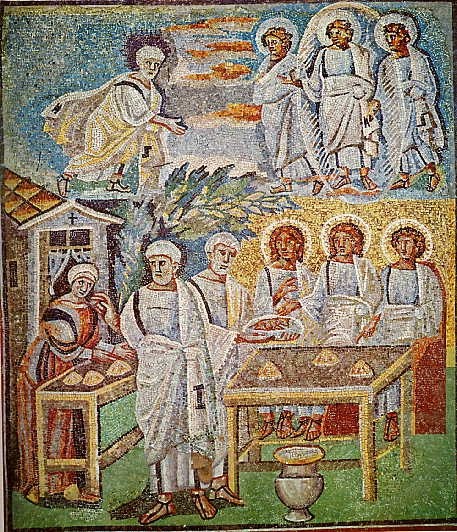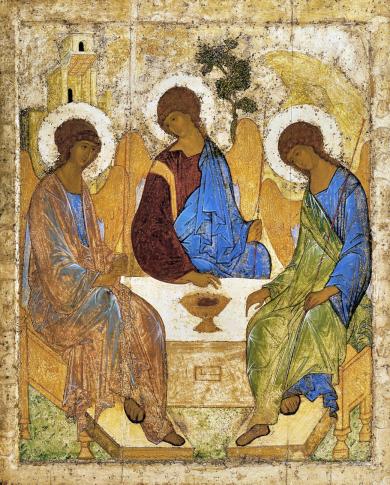![]()
So far in this short series, we have followed the development of the Church’s understanding of the story of the Hospitality of Abraham. In this post we will wrap up our discussion of the patristic dialog with Saints Cyril and Maximus.
Saint Cyril of Alexandria seems to have presented the most definitive and enduring interpretation regarding Genesis 18. The understanding expressed by Cyril seems to have prevailed and for this reason I deemed it worth the effort to translate an extended passage of his argument from an available Latin translation of the original Greek. Commenting on Genesis 18:1-3, 9-10a (LXX), Cyril writes:
Behold, clearly it says God appeared unto him, truly being three men in appearance, the Holy Abraham approaching from afar speaking not as if to three: “Lords, if indeed I have found grace in your (pl.) sight, pass not by your (pl.) son,” but calling upon the threefold Lord singularly, as if to one, so that they might turn aside unto him, he asked “when,” and as one appearing in three, even as from one persona, they said, “Where is Sarra thy wife?” and responded, “I will come when the time is ripe.”
Discern therefore, discern indeed three appearing, and each identified by its respective hypostasis,1 in word subject to the consubstantial three comprehended in one, and thus intermingling the given work of conversation among themselves. But the likenesses of this mode are obscured in a certain way and are inferior to the truth, unless in some way they are to be used as a hand leading us into knowledge of their properties, which surpass the intellect and speech (obviously the light of the divine vision will penetrate only the most pure intellects), and as from these things which fall to the senses we fly unto that which to our senses and strength of reasoning are very far.
Singular, therefore, by the unanimity of all persons, is the nature of divinity, which is over all, through all and in all: through intellectual means, verily, this is extrapolated to the holy, venerable, and consubstantial Trinity, into the Father, I say, and the Son, and the Holy Spirit… Our progenitor Abraham, therefore, was not ignorant of the worship of the Holy Trinity…2
Cyril’s portrayal of the three speaking in unison is remarkable. He describes the three who appear to Abraham as likenesses that, while not the fullness of the truth, lead us, as if by the hand, into knowledge of God. He asserts that an understanding of the Holy Trinity can be discerned from this type through the application of the intellect. With Cyril we have completed the transition from a Christological to a Trinitarian interpretation.
 Saint Maximus, in his Third Dialog on the Holy Trinity, affirms Saint Cyril’s view, arguing likewise that Abraham spoke to three as to one.3 At one point in the dialog, the dialogist known as ‘Orthodox’ literally states that “the three men were God,”4 while his challenger ‘Macedonius’ insists that only one of the three was God and the others were angels. Saint John Damascene agrees with the imagery, yet makes certain to clarify that, “Abraham saw not the nature of God, for no man ever saw God, but the image of God, and falling down he adored.”5
Saint Maximus, in his Third Dialog on the Holy Trinity, affirms Saint Cyril’s view, arguing likewise that Abraham spoke to three as to one.3 At one point in the dialog, the dialogist known as ‘Orthodox’ literally states that “the three men were God,”4 while his challenger ‘Macedonius’ insists that only one of the three was God and the others were angels. Saint John Damascene agrees with the imagery, yet makes certain to clarify that, “Abraham saw not the nature of God, for no man ever saw God, but the image of God, and falling down he adored.”5
It is interesting to observe that many, if not most, of the arguments made by the Fathers pivot on a precise interpretation of the literal words in Genesis 18. For instance, the Fathers carefully point out an address made in the singular, or an act done in the plural (e.g. the three measures of flour). Each word of Scripture is deemed significant.
In summary, the writings of the Holy Fathers reveal a progression in understanding of the story of The Hospitality of Abraham. In the earliest times all three persons are seen to be angels. In the second century a Christological interpretation is introduced. As we progress through the later fathers, the three men come to be seen as a type of the Holy Trinity, and even as a true theophany, not only of the Son, but of the entire Trinity. Ouspensky and Lossky clarify that the differences present in the latter two views do not change the understanding of the event because all the fullness of the Godhead is present in each Person. Consequently the earlier interpretation does not preclude a Trinitarian understanding.6
In our next post in this series, we will take a brief look at the liturgical witness to this story.
1 The latin word is subsistentia, which has a very similar meaning to the Greek hypostasis.
2 Saint Cyril of Alexandria, ‘Pro Sancta Christianorum Religione, Adversos Libros Athei Iuliani,’ in Cyrillii Alexandriae Archiepiscopi Operum, ed. Joannis Auberti, v. 6, b. 1, p. 20.
3 Saint Maximus the Confessor, ‘Opera Omnia,’ ed. Francisci Combefis, v. 2, p. 442.
4 Tres viri fuerunt Deus.
5 Saint John Damascene, ‘On Holy Images,’ trans. Mary H. Allies, (London:Thomas Baker 1898), Christian Classics Ethereal Library, Calvin College.
6 Leonid Ouspensky and Vladimir Lossky, ‘The Meaning of Icons,’ (Yonkers:Saint Vladimir’s Seminary Press 1982), p. 201.

 Having wrapped up my diatribe on the
Having wrapped up my diatribe on the